Employee Training Significance in Boosting Profit: An ASDA Study
VerifiedAdded on 2023/06/12
|33
|7253
|186
Thesis and Dissertation
AI Summary
This dissertation explores the significance of employee training in enhancing organizational profit, using ASDA as a case study. It begins with an introduction outlining the importance of employee training in a competitive business environment, particularly for improving organizational profitability. The literature review delves into the meaning of employee training, its importance in increasing organizational profit, and the challenges faced when training is eliminated. The research methods and methodology section details the approach used in gathering and analyzing data. The findings and data analysis chapter presents the results of the study, while the conclusion, recommendation, and implications for further research chapter summarizes the key findings and suggests areas for future investigation. The study emphasizes that employee training programs play a significant role in an organization's performance by improving employee skills, knowledge, and adaptability to market developments, ultimately impacting the company's profit and profitability. ASDA's focus on expanding its staff training program to increase profit is also highlighted.

Dissertation
Paraphrase This Document
Need a fresh take? Get an instant paraphrase of this document with our AI Paraphraser
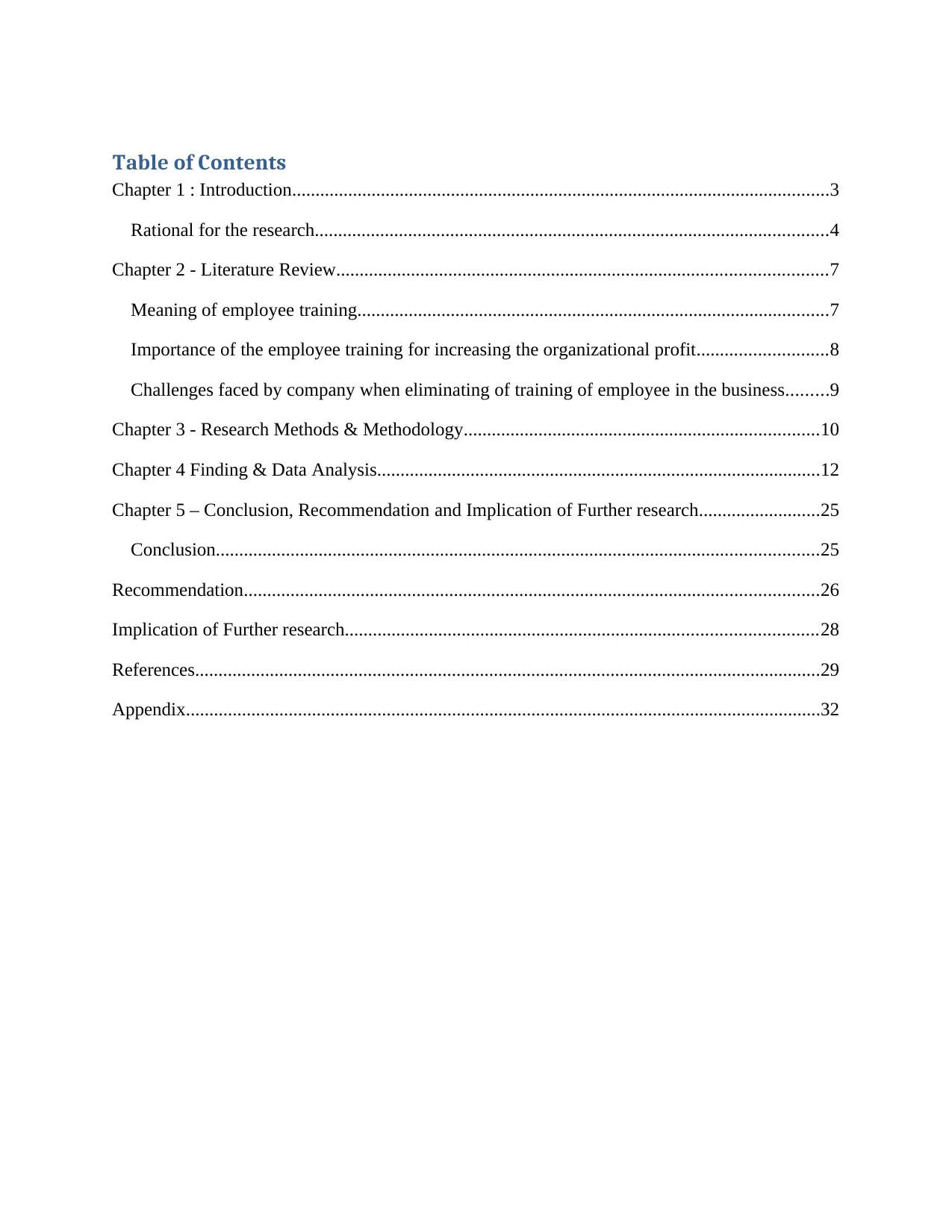
Table of Contents
Chapter 1 : Introduction...................................................................................................................3
Rational for the research..............................................................................................................4
Chapter 2 - Literature Review.........................................................................................................7
Meaning of employee training.....................................................................................................7
Importance of the employee training for increasing the organizational profit............................8
Challenges faced by company when eliminating of training of employee in the business.........9
Chapter 3 - Research Methods & Methodology............................................................................10
Chapter 4 Finding & Data Analysis...............................................................................................12
Chapter 5 – Conclusion, Recommendation and Implication of Further research..........................25
Conclusion.................................................................................................................................25
Recommendation...........................................................................................................................26
Implication of Further research.....................................................................................................28
References......................................................................................................................................29
Appendix........................................................................................................................................32
Chapter 1 : Introduction...................................................................................................................3
Rational for the research..............................................................................................................4
Chapter 2 - Literature Review.........................................................................................................7
Meaning of employee training.....................................................................................................7
Importance of the employee training for increasing the organizational profit............................8
Challenges faced by company when eliminating of training of employee in the business.........9
Chapter 3 - Research Methods & Methodology............................................................................10
Chapter 4 Finding & Data Analysis...............................................................................................12
Chapter 5 – Conclusion, Recommendation and Implication of Further research..........................25
Conclusion.................................................................................................................................25
Recommendation...........................................................................................................................26
Implication of Further research.....................................................................................................28
References......................................................................................................................................29
Appendix........................................................................................................................................32
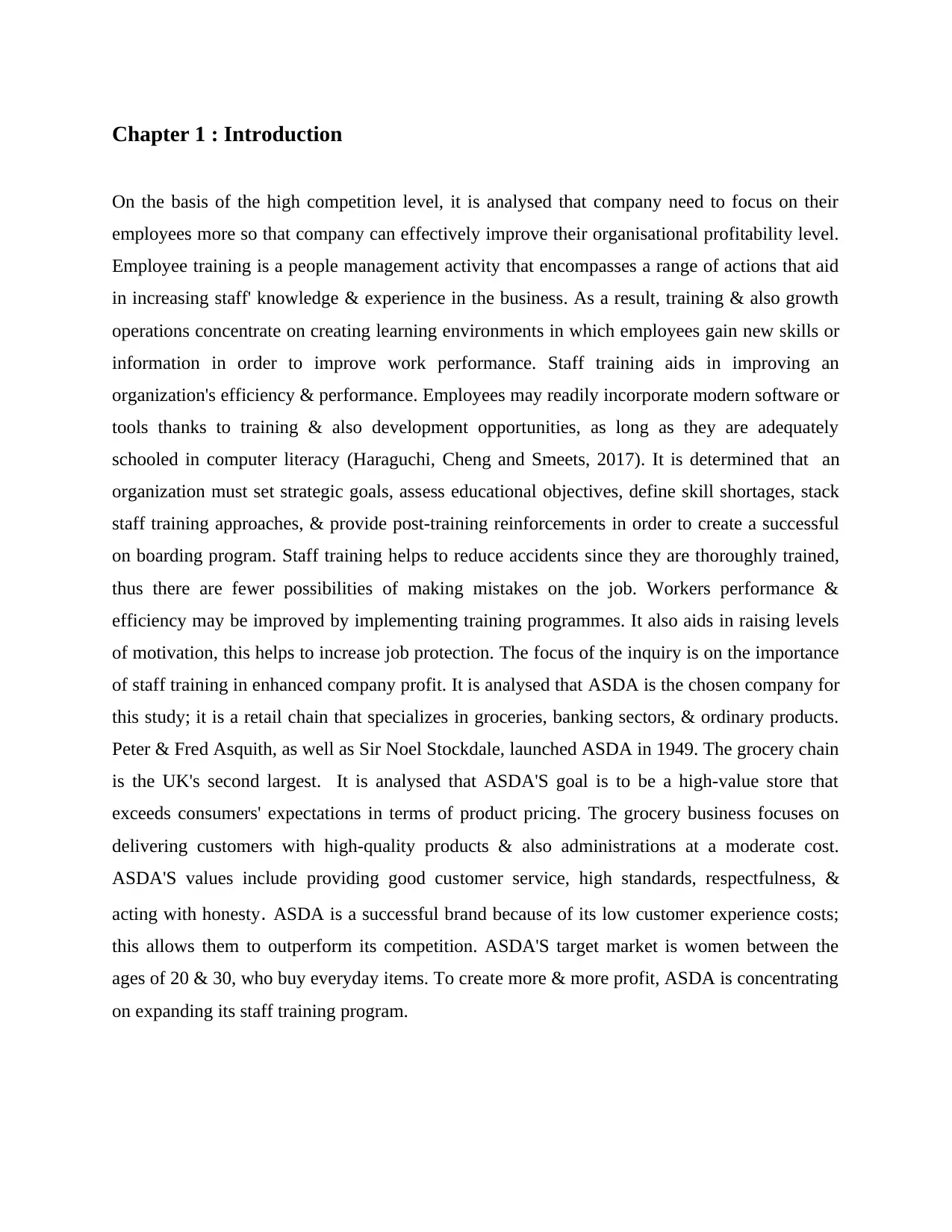
Chapter 1 : Introduction
On the basis of the high competition level, it is analysed that company need to focus on their
employees more so that company can effectively improve their organisational profitability level.
Employee training is a people management activity that encompasses a range of actions that aid
in increasing staff' knowledge & experience in the business. As a result, training & also growth
operations concentrate on creating learning environments in which employees gain new skills or
information in order to improve work performance. Staff training aids in improving an
organization's efficiency & performance. Employees may readily incorporate modern software or
tools thanks to training & also development opportunities, as long as they are adequately
schooled in computer literacy (Haraguchi, Cheng and Smeets, 2017). It is determined that an
organization must set strategic goals, assess educational objectives, define skill shortages, stack
staff training approaches, & provide post-training reinforcements in order to create a successful
on boarding program. Staff training helps to reduce accidents since they are thoroughly trained,
thus there are fewer possibilities of making mistakes on the job. Workers performance &
efficiency may be improved by implementing training programmes. It also aids in raising levels
of motivation, this helps to increase job protection. The focus of the inquiry is on the importance
of staff training in enhanced company profit. It is analysed that ASDA is the chosen company for
this study; it is a retail chain that specializes in groceries, banking sectors, & ordinary products.
Peter & Fred Asquith, as well as Sir Noel Stockdale, launched ASDA in 1949. The grocery chain
is the UK's second largest. It is analysed that ASDA'S goal is to be a high-value store that
exceeds consumers' expectations in terms of product pricing. The grocery business focuses on
delivering customers with high-quality products & also administrations at a moderate cost.
ASDA'S values include providing good customer service, high standards, respectfulness, &
acting with honesty. ASDA is a successful brand because of its low customer experience costs;
this allows them to outperform its competition. ASDA'S target market is women between the
ages of 20 & 30, who buy everyday items. To create more & more profit, ASDA is concentrating
on expanding its staff training program.
On the basis of the high competition level, it is analysed that company need to focus on their
employees more so that company can effectively improve their organisational profitability level.
Employee training is a people management activity that encompasses a range of actions that aid
in increasing staff' knowledge & experience in the business. As a result, training & also growth
operations concentrate on creating learning environments in which employees gain new skills or
information in order to improve work performance. Staff training aids in improving an
organization's efficiency & performance. Employees may readily incorporate modern software or
tools thanks to training & also development opportunities, as long as they are adequately
schooled in computer literacy (Haraguchi, Cheng and Smeets, 2017). It is determined that an
organization must set strategic goals, assess educational objectives, define skill shortages, stack
staff training approaches, & provide post-training reinforcements in order to create a successful
on boarding program. Staff training helps to reduce accidents since they are thoroughly trained,
thus there are fewer possibilities of making mistakes on the job. Workers performance &
efficiency may be improved by implementing training programmes. It also aids in raising levels
of motivation, this helps to increase job protection. The focus of the inquiry is on the importance
of staff training in enhanced company profit. It is analysed that ASDA is the chosen company for
this study; it is a retail chain that specializes in groceries, banking sectors, & ordinary products.
Peter & Fred Asquith, as well as Sir Noel Stockdale, launched ASDA in 1949. The grocery chain
is the UK's second largest. It is analysed that ASDA'S goal is to be a high-value store that
exceeds consumers' expectations in terms of product pricing. The grocery business focuses on
delivering customers with high-quality products & also administrations at a moderate cost.
ASDA'S values include providing good customer service, high standards, respectfulness, &
acting with honesty. ASDA is a successful brand because of its low customer experience costs;
this allows them to outperform its competition. ASDA'S target market is women between the
ages of 20 & 30, who buy everyday items. To create more & more profit, ASDA is concentrating
on expanding its staff training program.
⊘ This is a preview!⊘
Do you want full access?
Subscribe today to unlock all pages.

Trusted by 1+ million students worldwide
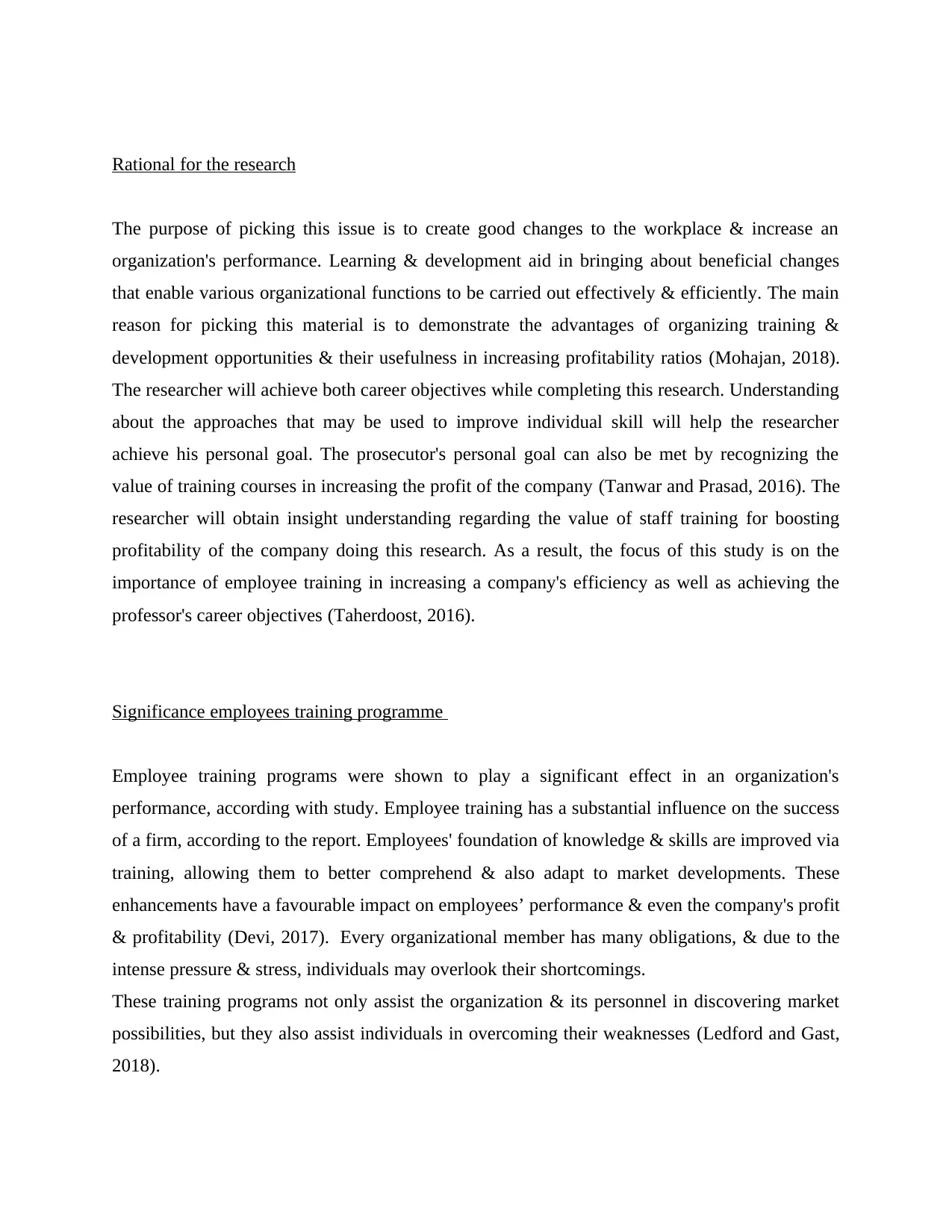
Rational for the research
The purpose of picking this issue is to create good changes to the workplace & increase an
organization's performance. Learning & development aid in bringing about beneficial changes
that enable various organizational functions to be carried out effectively & efficiently. The main
reason for picking this material is to demonstrate the advantages of organizing training &
development opportunities & their usefulness in increasing profitability ratios (Mohajan, 2018).
The researcher will achieve both career objectives while completing this research. Understanding
about the approaches that may be used to improve individual skill will help the researcher
achieve his personal goal. The prosecutor's personal goal can also be met by recognizing the
value of training courses in increasing the profit of the company (Tanwar and Prasad, 2016). The
researcher will obtain insight understanding regarding the value of staff training for boosting
profitability of the company doing this research. As a result, the focus of this study is on the
importance of employee training in increasing a company's efficiency as well as achieving the
professor's career objectives (Taherdoost, 2016).
Significance employees training programme
Employee training programs were shown to play a significant effect in an organization's
performance, according with study. Employee training has a substantial influence on the success
of a firm, according to the report. Employees' foundation of knowledge & skills are improved via
training, allowing them to better comprehend & also adapt to market developments. These
enhancements have a favourable impact on employees’ performance & even the company's profit
& profitability (Devi, 2017). Every organizational member has many obligations, & due to the
intense pressure & stress, individuals may overlook their shortcomings.
These training programs not only assist the organization & its personnel in discovering market
possibilities, but they also assist individuals in overcoming their weaknesses (Ledford and Gast,
2018).
The purpose of picking this issue is to create good changes to the workplace & increase an
organization's performance. Learning & development aid in bringing about beneficial changes
that enable various organizational functions to be carried out effectively & efficiently. The main
reason for picking this material is to demonstrate the advantages of organizing training &
development opportunities & their usefulness in increasing profitability ratios (Mohajan, 2018).
The researcher will achieve both career objectives while completing this research. Understanding
about the approaches that may be used to improve individual skill will help the researcher
achieve his personal goal. The prosecutor's personal goal can also be met by recognizing the
value of training courses in increasing the profit of the company (Tanwar and Prasad, 2016). The
researcher will obtain insight understanding regarding the value of staff training for boosting
profitability of the company doing this research. As a result, the focus of this study is on the
importance of employee training in increasing a company's efficiency as well as achieving the
professor's career objectives (Taherdoost, 2016).
Significance employees training programme
Employee training programs were shown to play a significant effect in an organization's
performance, according with study. Employee training has a substantial influence on the success
of a firm, according to the report. Employees' foundation of knowledge & skills are improved via
training, allowing them to better comprehend & also adapt to market developments. These
enhancements have a favourable impact on employees’ performance & even the company's profit
& profitability (Devi, 2017). Every organizational member has many obligations, & due to the
intense pressure & stress, individuals may overlook their shortcomings.
These training programs not only assist the organization & its personnel in discovering market
possibilities, but they also assist individuals in overcoming their weaknesses (Ledford and Gast,
2018).
Paraphrase This Document
Need a fresh take? Get an instant paraphrase of this document with our AI Paraphraser
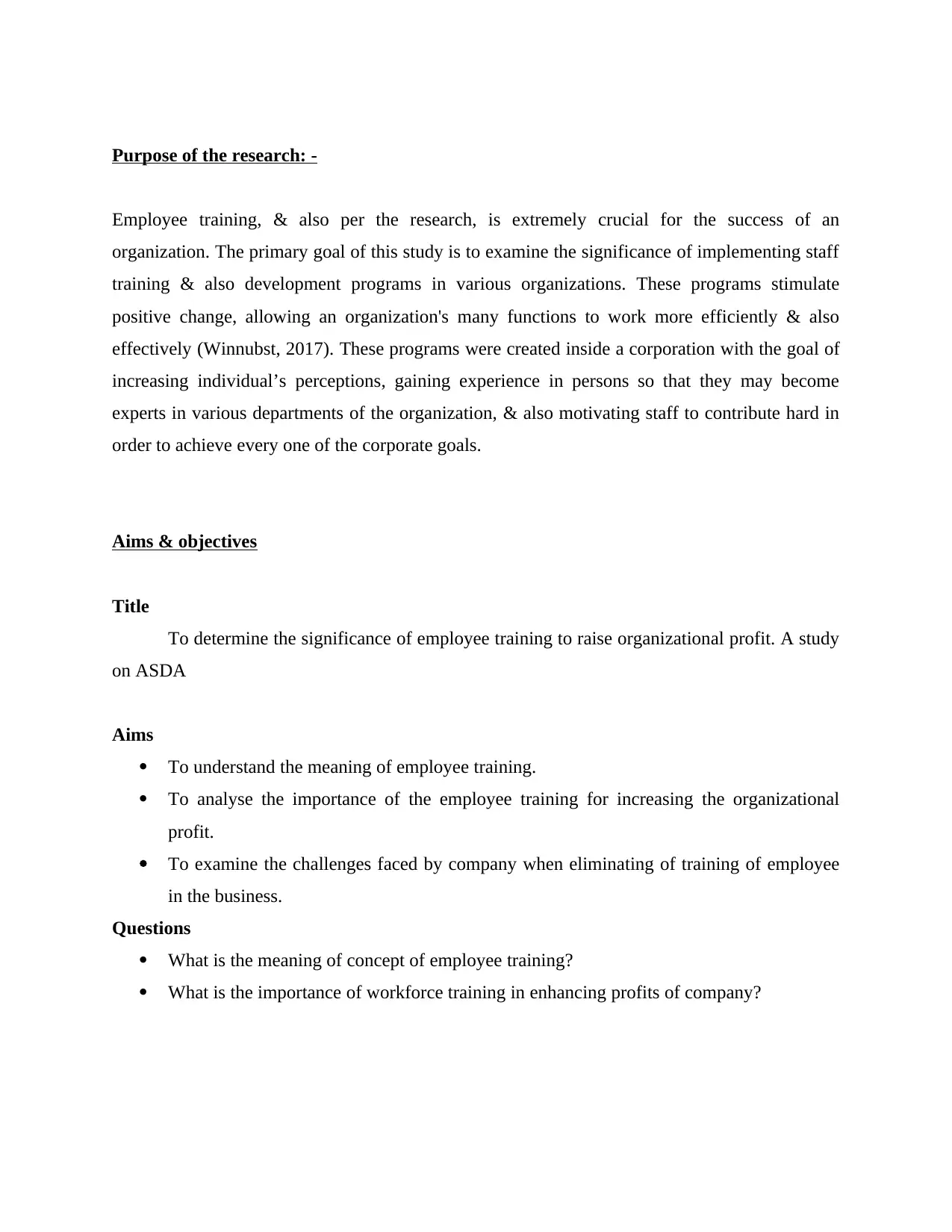
Purpose of the research: -
Employee training, & also per the research, is extremely crucial for the success of an
organization. The primary goal of this study is to examine the significance of implementing staff
training & also development programs in various organizations. These programs stimulate
positive change, allowing an organization's many functions to work more efficiently & also
effectively (Winnubst, 2017). These programs were created inside a corporation with the goal of
increasing individual’s perceptions, gaining experience in persons so that they may become
experts in various departments of the organization, & also motivating staff to contribute hard in
order to achieve every one of the corporate goals.
Aims & objectives
Title
To determine the significance of employee training to raise organizational profit. A study
on ASDA
Aims
To understand the meaning of employee training.
To analyse the importance of the employee training for increasing the organizational
profit.
To examine the challenges faced by company when eliminating of training of employee
in the business.
Questions
What is the meaning of concept of employee training?
What is the importance of workforce training in enhancing profits of company?
Employee training, & also per the research, is extremely crucial for the success of an
organization. The primary goal of this study is to examine the significance of implementing staff
training & also development programs in various organizations. These programs stimulate
positive change, allowing an organization's many functions to work more efficiently & also
effectively (Winnubst, 2017). These programs were created inside a corporation with the goal of
increasing individual’s perceptions, gaining experience in persons so that they may become
experts in various departments of the organization, & also motivating staff to contribute hard in
order to achieve every one of the corporate goals.
Aims & objectives
Title
To determine the significance of employee training to raise organizational profit. A study
on ASDA
Aims
To understand the meaning of employee training.
To analyse the importance of the employee training for increasing the organizational
profit.
To examine the challenges faced by company when eliminating of training of employee
in the business.
Questions
What is the meaning of concept of employee training?
What is the importance of workforce training in enhancing profits of company?
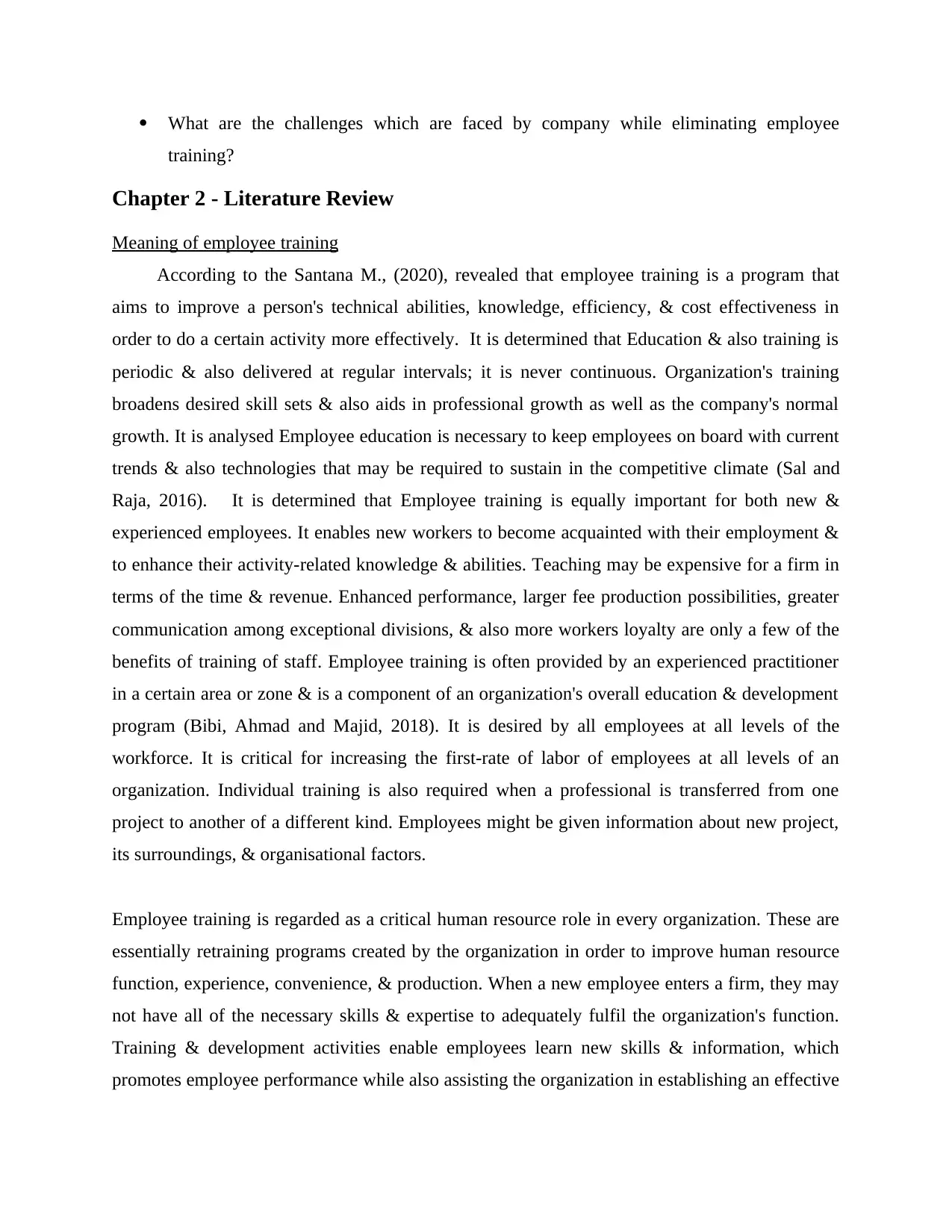
What are the challenges which are faced by company while eliminating employee
training?
Chapter 2 - Literature Review
Meaning of employee training
According to the Santana M., (2020), revealed that employee training is a program that
aims to improve a person's technical abilities, knowledge, efficiency, & cost effectiveness in
order to do a certain activity more effectively. It is determined that Education & also training is
periodic & also delivered at regular intervals; it is never continuous. Organization's training
broadens desired skill sets & also aids in professional growth as well as the company's normal
growth. It is analysed Employee education is necessary to keep employees on board with current
trends & also technologies that may be required to sustain in the competitive climate (Sal and
Raja, 2016). It is determined that Employee training is equally important for both new &
experienced employees. It enables new workers to become acquainted with their employment &
to enhance their activity-related knowledge & abilities. Teaching may be expensive for a firm in
terms of the time & revenue. Enhanced performance, larger fee production possibilities, greater
communication among exceptional divisions, & also more workers loyalty are only a few of the
benefits of training of staff. Employee training is often provided by an experienced practitioner
in a certain area or zone & is a component of an organization's overall education & development
program (Bibi, Ahmad and Majid, 2018). It is desired by all employees at all levels of the
workforce. It is critical for increasing the first-rate of labor of employees at all levels of an
organization. Individual training is also required when a professional is transferred from one
project to another of a different kind. Employees might be given information about new project,
its surroundings, & organisational factors.
Employee training is regarded as a critical human resource role in every organization. These are
essentially retraining programs created by the organization in order to improve human resource
function, experience, convenience, & production. When a new employee enters a firm, they may
not have all of the necessary skills & expertise to adequately fulfil the organization's function.
Training & development activities enable employees learn new skills & information, which
promotes employee performance while also assisting the organization in establishing an effective
training?
Chapter 2 - Literature Review
Meaning of employee training
According to the Santana M., (2020), revealed that employee training is a program that
aims to improve a person's technical abilities, knowledge, efficiency, & cost effectiveness in
order to do a certain activity more effectively. It is determined that Education & also training is
periodic & also delivered at regular intervals; it is never continuous. Organization's training
broadens desired skill sets & also aids in professional growth as well as the company's normal
growth. It is analysed Employee education is necessary to keep employees on board with current
trends & also technologies that may be required to sustain in the competitive climate (Sal and
Raja, 2016). It is determined that Employee training is equally important for both new &
experienced employees. It enables new workers to become acquainted with their employment &
to enhance their activity-related knowledge & abilities. Teaching may be expensive for a firm in
terms of the time & revenue. Enhanced performance, larger fee production possibilities, greater
communication among exceptional divisions, & also more workers loyalty are only a few of the
benefits of training of staff. Employee training is often provided by an experienced practitioner
in a certain area or zone & is a component of an organization's overall education & development
program (Bibi, Ahmad and Majid, 2018). It is desired by all employees at all levels of the
workforce. It is critical for increasing the first-rate of labor of employees at all levels of an
organization. Individual training is also required when a professional is transferred from one
project to another of a different kind. Employees might be given information about new project,
its surroundings, & organisational factors.
Employee training is regarded as a critical human resource role in every organization. These are
essentially retraining programs created by the organization in order to improve human resource
function, experience, convenience, & production. When a new employee enters a firm, they may
not have all of the necessary skills & expertise to adequately fulfil the organization's function.
Training & development activities enable employees learn new skills & information, which
promotes employee performance while also assisting the organization in establishing an effective
⊘ This is a preview!⊘
Do you want full access?
Subscribe today to unlock all pages.

Trusted by 1+ million students worldwide
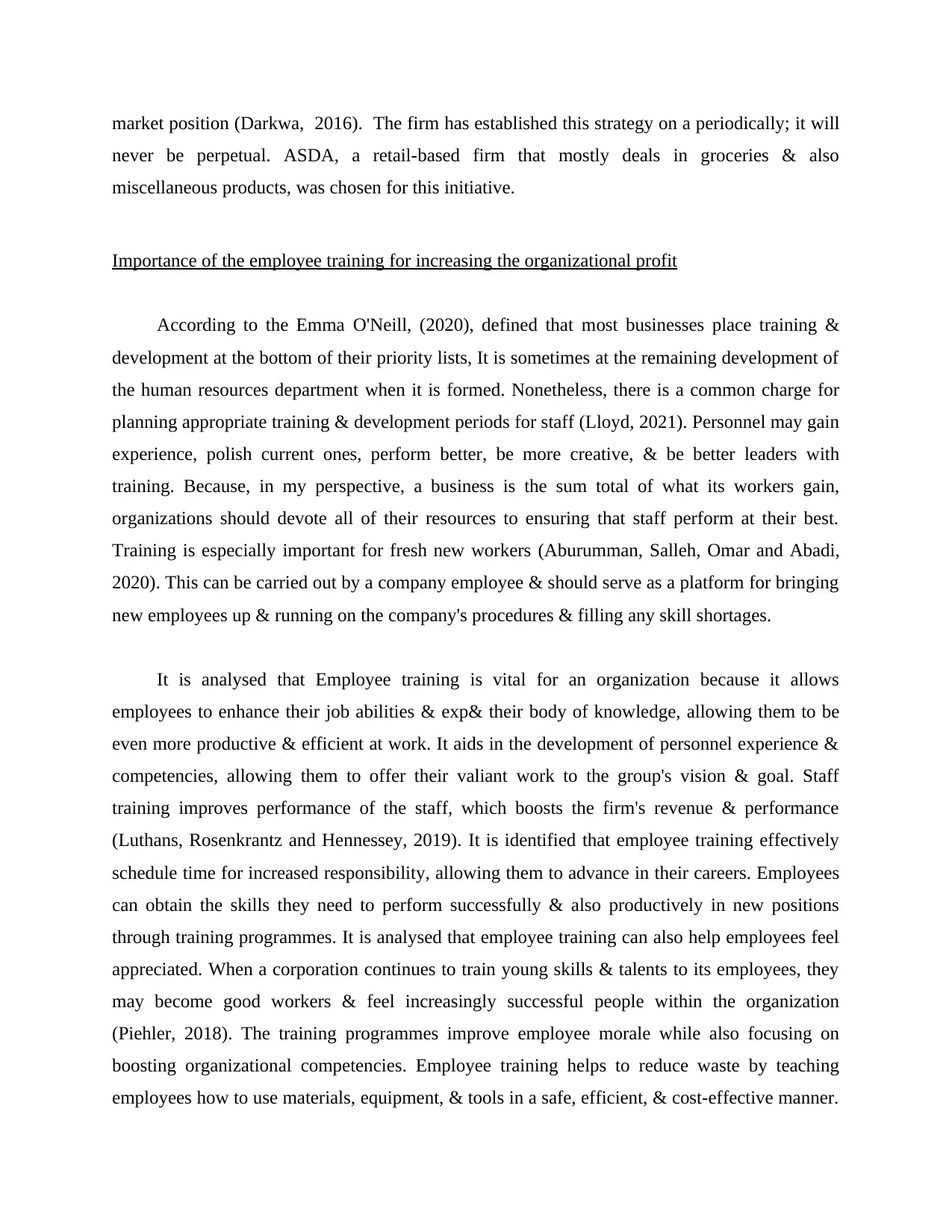
market position (Darkwa, 2016). The firm has established this strategy on a periodically; it will
never be perpetual. ASDA, a retail-based firm that mostly deals in groceries & also
miscellaneous products, was chosen for this initiative.
Importance of the employee training for increasing the organizational profit
According to the Emma O'Neill, (2020), defined that most businesses place training &
development at the bottom of their priority lists, It is sometimes at the remaining development of
the human resources department when it is formed. Nonetheless, there is a common charge for
planning appropriate training & development periods for staff (Lloyd, 2021). Personnel may gain
experience, polish current ones, perform better, be more creative, & be better leaders with
training. Because, in my perspective, a business is the sum total of what its workers gain,
organizations should devote all of their resources to ensuring that staff perform at their best.
Training is especially important for fresh new workers (Aburumman, Salleh, Omar and Abadi,
2020). This can be carried out by a company employee & should serve as a platform for bringing
new employees up & running on the company's procedures & filling any skill shortages.
It is analysed that Employee training is vital for an organization because it allows
employees to enhance their job abilities & exp& their body of knowledge, allowing them to be
even more productive & efficient at work. It aids in the development of personnel experience &
competencies, allowing them to offer their valiant work to the group's vision & goal. Staff
training improves performance of the staff, which boosts the firm's revenue & performance
(Luthans, Rosenkrantz and Hennessey, 2019). It is identified that employee training effectively
schedule time for increased responsibility, allowing them to advance in their careers. Employees
can obtain the skills they need to perform successfully & also productively in new positions
through training programmes. It is analysed that employee training can also help employees feel
appreciated. When a corporation continues to train young skills & talents to its employees, they
may become good workers & feel increasingly successful people within the organization
(Piehler, 2018). The training programmes improve employee morale while also focusing on
boosting organizational competencies. Employee training helps to reduce waste by teaching
employees how to use materials, equipment, & tools in a safe, efficient, & cost-effective manner.
never be perpetual. ASDA, a retail-based firm that mostly deals in groceries & also
miscellaneous products, was chosen for this initiative.
Importance of the employee training for increasing the organizational profit
According to the Emma O'Neill, (2020), defined that most businesses place training &
development at the bottom of their priority lists, It is sometimes at the remaining development of
the human resources department when it is formed. Nonetheless, there is a common charge for
planning appropriate training & development periods for staff (Lloyd, 2021). Personnel may gain
experience, polish current ones, perform better, be more creative, & be better leaders with
training. Because, in my perspective, a business is the sum total of what its workers gain,
organizations should devote all of their resources to ensuring that staff perform at their best.
Training is especially important for fresh new workers (Aburumman, Salleh, Omar and Abadi,
2020). This can be carried out by a company employee & should serve as a platform for bringing
new employees up & running on the company's procedures & filling any skill shortages.
It is analysed that Employee training is vital for an organization because it allows
employees to enhance their job abilities & exp& their body of knowledge, allowing them to be
even more productive & efficient at work. It aids in the development of personnel experience &
competencies, allowing them to offer their valiant work to the group's vision & goal. Staff
training improves performance of the staff, which boosts the firm's revenue & performance
(Luthans, Rosenkrantz and Hennessey, 2019). It is identified that employee training effectively
schedule time for increased responsibility, allowing them to advance in their careers. Employees
can obtain the skills they need to perform successfully & also productively in new positions
through training programmes. It is analysed that employee training can also help employees feel
appreciated. When a corporation continues to train young skills & talents to its employees, they
may become good workers & feel increasingly successful people within the organization
(Piehler, 2018). The training programmes improve employee morale while also focusing on
boosting organizational competencies. Employee training helps to reduce waste by teaching
employees how to use materials, equipment, & tools in a safe, efficient, & cost-effective manner.
Paraphrase This Document
Need a fresh take? Get an instant paraphrase of this document with our AI Paraphraser
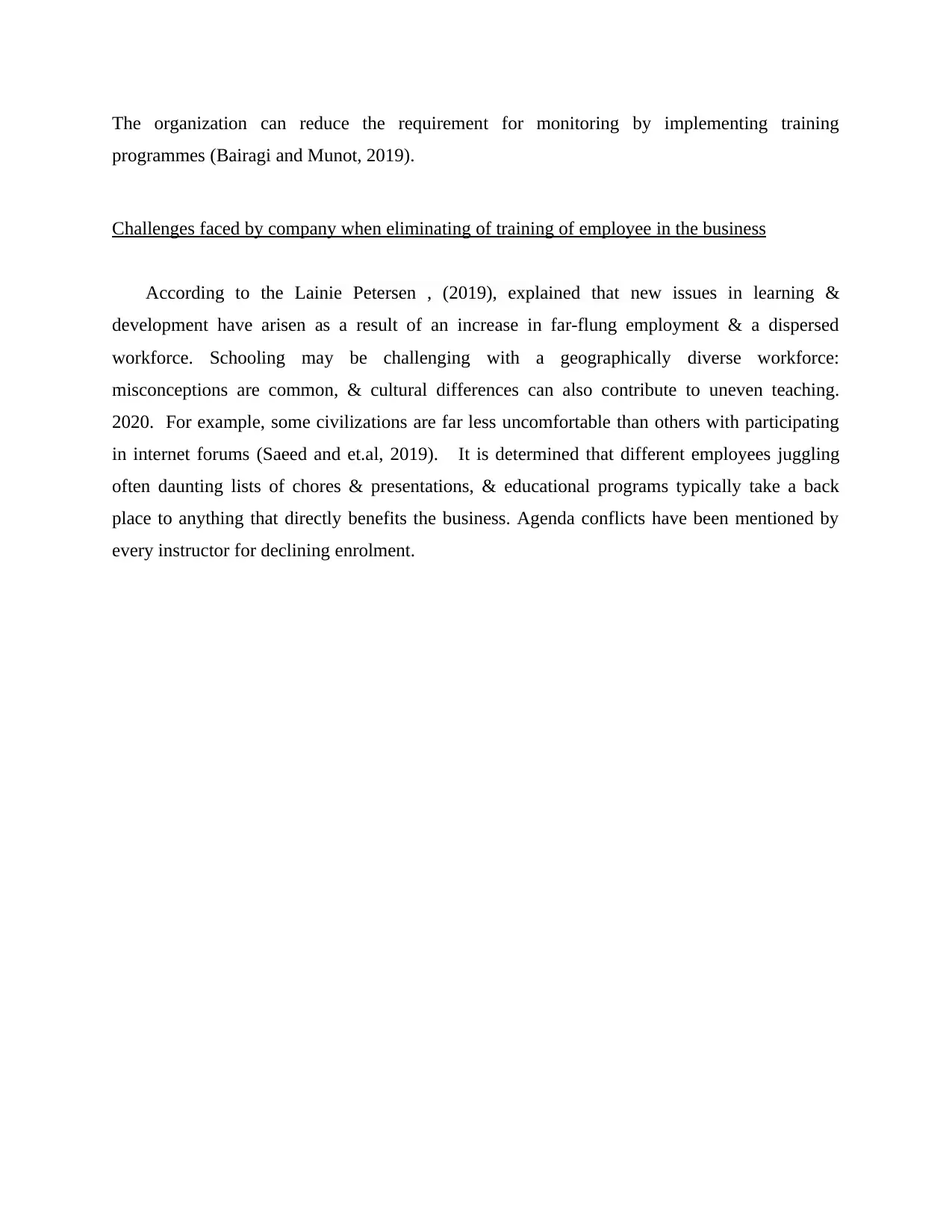
The organization can reduce the requirement for monitoring by implementing training
programmes (Bairagi and Munot, 2019).
Challenges faced by company when eliminating of training of employee in the business
According to the Lainie Petersen , (2019), explained that new issues in learning &
development have arisen as a result of an increase in far-flung employment & a dispersed
workforce. Schooling may be challenging with a geographically diverse workforce:
misconceptions are common, & cultural differences can also contribute to uneven teaching.
2020. For example, some civilizations are far less uncomfortable than others with participating
in internet forums (Saeed and et.al, 2019). It is determined that different employees juggling
often daunting lists of chores & presentations, & educational programs typically take a back
place to anything that directly benefits the business. Agenda conflicts have been mentioned by
every instructor for declining enrolment.
programmes (Bairagi and Munot, 2019).
Challenges faced by company when eliminating of training of employee in the business
According to the Lainie Petersen , (2019), explained that new issues in learning &
development have arisen as a result of an increase in far-flung employment & a dispersed
workforce. Schooling may be challenging with a geographically diverse workforce:
misconceptions are common, & cultural differences can also contribute to uneven teaching.
2020. For example, some civilizations are far less uncomfortable than others with participating
in internet forums (Saeed and et.al, 2019). It is determined that different employees juggling
often daunting lists of chores & presentations, & educational programs typically take a back
place to anything that directly benefits the business. Agenda conflicts have been mentioned by
every instructor for declining enrolment.
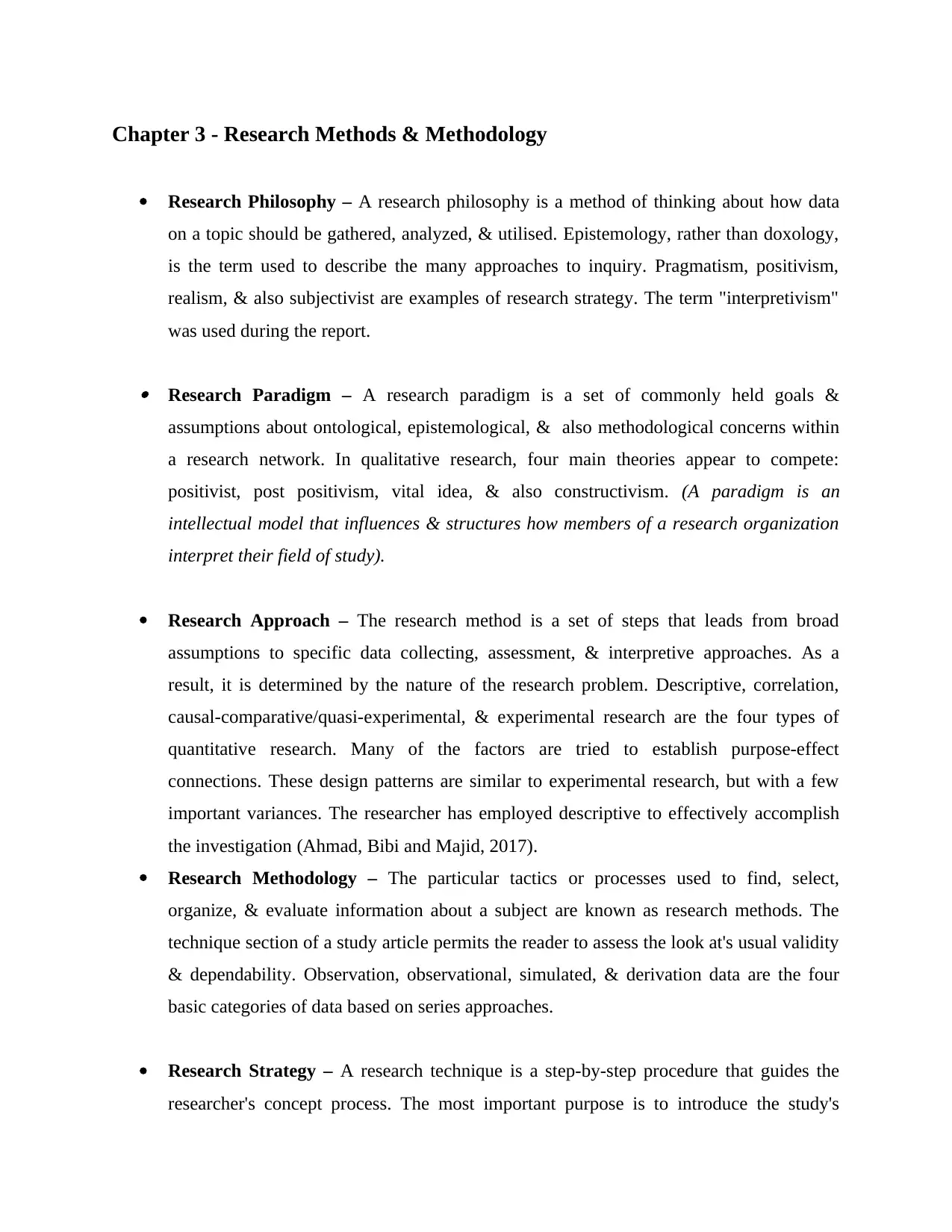
Chapter 3 - Research Methods & Methodology
Research Philosophy – A research philosophy is a method of thinking about how data
on a topic should be gathered, analyzed, & utilised. Epistemology, rather than doxology,
is the term used to describe the many approaches to inquiry. Pragmatism, positivism,
realism, & also subjectivist are examples of research strategy. The term "interpretivism"
was used during the report.
Research Paradigm – A research paradigm is a set of commonly held goals &
assumptions about ontological, epistemological, & also methodological concerns within
a research network. In qualitative research, four main theories appear to compete:
positivist, post positivism, vital idea, & also constructivism. (A paradigm is an
intellectual model that influences & structures how members of a research organization
interpret their field of study).
Research Approach – The research method is a set of steps that leads from broad
assumptions to specific data collecting, assessment, & interpretive approaches. As a
result, it is determined by the nature of the research problem. Descriptive, correlation,
causal-comparative/quasi-experimental, & experimental research are the four types of
quantitative research. Many of the factors are tried to establish purpose-effect
connections. These design patterns are similar to experimental research, but with a few
important variances. The researcher has employed descriptive to effectively accomplish
the investigation (Ahmad, Bibi and Majid, 2017).
Research Methodology – The particular tactics or processes used to find, select,
organize, & evaluate information about a subject are known as research methods. The
technique section of a study article permits the reader to assess the look at's usual validity
& dependability. Observation, observational, simulated, & derivation data are the four
basic categories of data based on series approaches.
Research Strategy – A research technique is a step-by-step procedure that guides the
researcher's concept process. The most important purpose is to introduce the study's
Research Philosophy – A research philosophy is a method of thinking about how data
on a topic should be gathered, analyzed, & utilised. Epistemology, rather than doxology,
is the term used to describe the many approaches to inquiry. Pragmatism, positivism,
realism, & also subjectivist are examples of research strategy. The term "interpretivism"
was used during the report.
Research Paradigm – A research paradigm is a set of commonly held goals &
assumptions about ontological, epistemological, & also methodological concerns within
a research network. In qualitative research, four main theories appear to compete:
positivist, post positivism, vital idea, & also constructivism. (A paradigm is an
intellectual model that influences & structures how members of a research organization
interpret their field of study).
Research Approach – The research method is a set of steps that leads from broad
assumptions to specific data collecting, assessment, & interpretive approaches. As a
result, it is determined by the nature of the research problem. Descriptive, correlation,
causal-comparative/quasi-experimental, & experimental research are the four types of
quantitative research. Many of the factors are tried to establish purpose-effect
connections. These design patterns are similar to experimental research, but with a few
important variances. The researcher has employed descriptive to effectively accomplish
the investigation (Ahmad, Bibi and Majid, 2017).
Research Methodology – The particular tactics or processes used to find, select,
organize, & evaluate information about a subject are known as research methods. The
technique section of a study article permits the reader to assess the look at's usual validity
& dependability. Observation, observational, simulated, & derivation data are the four
basic categories of data based on series approaches.
Research Strategy – A research technique is a step-by-step procedure that guides the
researcher's concept process. The most important purpose is to introduce the study's
⊘ This is a preview!⊘
Do you want full access?
Subscribe today to unlock all pages.

Trusted by 1+ million students worldwide
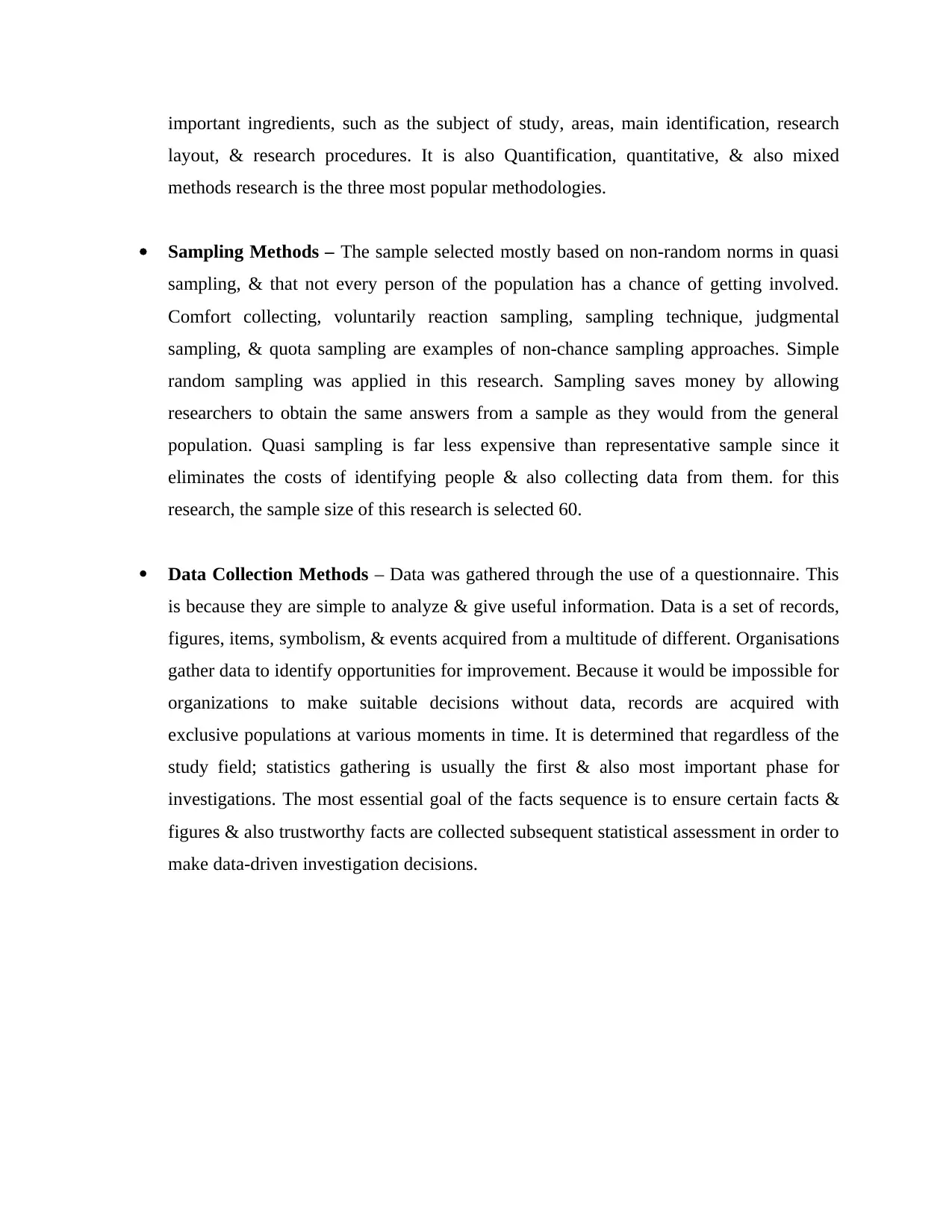
important ingredients, such as the subject of study, areas, main identification, research
layout, & research procedures. It is also Quantification, quantitative, & also mixed
methods research is the three most popular methodologies.
Sampling Methods – The sample selected mostly based on non-random norms in quasi
sampling, & that not every person of the population has a chance of getting involved.
Comfort collecting, voluntarily reaction sampling, sampling technique, judgmental
sampling, & quota sampling are examples of non-chance sampling approaches. Simple
random sampling was applied in this research. Sampling saves money by allowing
researchers to obtain the same answers from a sample as they would from the general
population. Quasi sampling is far less expensive than representative sample since it
eliminates the costs of identifying people & also collecting data from them. for this
research, the sample size of this research is selected 60.
Data Collection Methods – Data was gathered through the use of a questionnaire. This
is because they are simple to analyze & give useful information. Data is a set of records,
figures, items, symbolism, & events acquired from a multitude of different. Organisations
gather data to identify opportunities for improvement. Because it would be impossible for
organizations to make suitable decisions without data, records are acquired with
exclusive populations at various moments in time. It is determined that regardless of the
study field; statistics gathering is usually the first & also most important phase for
investigations. The most essential goal of the facts sequence is to ensure certain facts &
figures & also trustworthy facts are collected subsequent statistical assessment in order to
make data-driven investigation decisions.
layout, & research procedures. It is also Quantification, quantitative, & also mixed
methods research is the three most popular methodologies.
Sampling Methods – The sample selected mostly based on non-random norms in quasi
sampling, & that not every person of the population has a chance of getting involved.
Comfort collecting, voluntarily reaction sampling, sampling technique, judgmental
sampling, & quota sampling are examples of non-chance sampling approaches. Simple
random sampling was applied in this research. Sampling saves money by allowing
researchers to obtain the same answers from a sample as they would from the general
population. Quasi sampling is far less expensive than representative sample since it
eliminates the costs of identifying people & also collecting data from them. for this
research, the sample size of this research is selected 60.
Data Collection Methods – Data was gathered through the use of a questionnaire. This
is because they are simple to analyze & give useful information. Data is a set of records,
figures, items, symbolism, & events acquired from a multitude of different. Organisations
gather data to identify opportunities for improvement. Because it would be impossible for
organizations to make suitable decisions without data, records are acquired with
exclusive populations at various moments in time. It is determined that regardless of the
study field; statistics gathering is usually the first & also most important phase for
investigations. The most essential goal of the facts sequence is to ensure certain facts &
figures & also trustworthy facts are collected subsequent statistical assessment in order to
make data-driven investigation decisions.
Paraphrase This Document
Need a fresh take? Get an instant paraphrase of this document with our AI Paraphraser
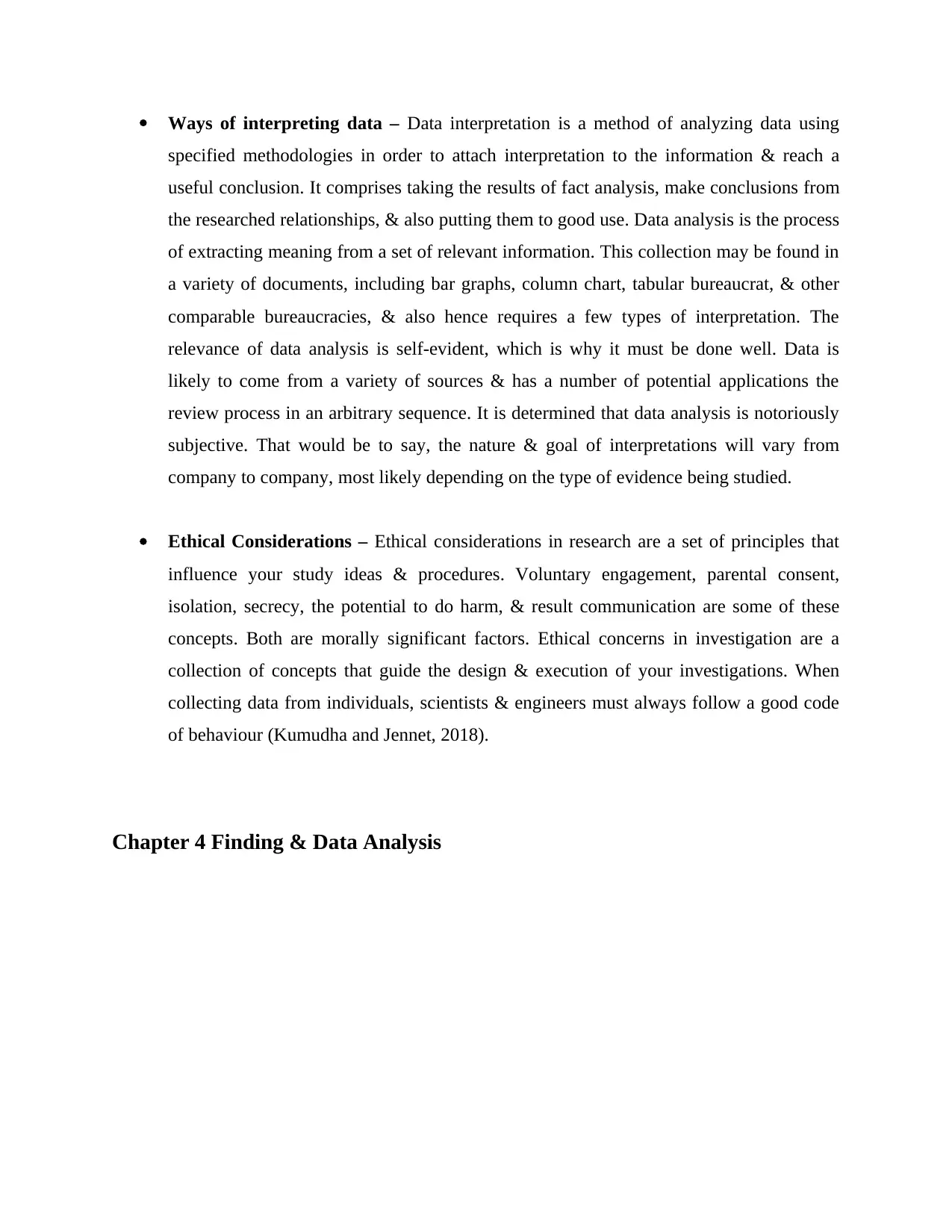
Ways of interpreting data – Data interpretation is a method of analyzing data using
specified methodologies in order to attach interpretation to the information & reach a
useful conclusion. It comprises taking the results of fact analysis, make conclusions from
the researched relationships, & also putting them to good use. Data analysis is the process
of extracting meaning from a set of relevant information. This collection may be found in
a variety of documents, including bar graphs, column chart, tabular bureaucrat, & other
comparable bureaucracies, & also hence requires a few types of interpretation. The
relevance of data analysis is self-evident, which is why it must be done well. Data is
likely to come from a variety of sources & has a number of potential applications the
review process in an arbitrary sequence. It is determined that data analysis is notoriously
subjective. That would be to say, the nature & goal of interpretations will vary from
company to company, most likely depending on the type of evidence being studied.
Ethical Considerations – Ethical considerations in research are a set of principles that
influence your study ideas & procedures. Voluntary engagement, parental consent,
isolation, secrecy, the potential to do harm, & result communication are some of these
concepts. Both are morally significant factors. Ethical concerns in investigation are a
collection of concepts that guide the design & execution of your investigations. When
collecting data from individuals, scientists & engineers must always follow a good code
of behaviour (Kumudha and Jennet, 2018).
Chapter 4 Finding & Data Analysis
specified methodologies in order to attach interpretation to the information & reach a
useful conclusion. It comprises taking the results of fact analysis, make conclusions from
the researched relationships, & also putting them to good use. Data analysis is the process
of extracting meaning from a set of relevant information. This collection may be found in
a variety of documents, including bar graphs, column chart, tabular bureaucrat, & other
comparable bureaucracies, & also hence requires a few types of interpretation. The
relevance of data analysis is self-evident, which is why it must be done well. Data is
likely to come from a variety of sources & has a number of potential applications the
review process in an arbitrary sequence. It is determined that data analysis is notoriously
subjective. That would be to say, the nature & goal of interpretations will vary from
company to company, most likely depending on the type of evidence being studied.
Ethical Considerations – Ethical considerations in research are a set of principles that
influence your study ideas & procedures. Voluntary engagement, parental consent,
isolation, secrecy, the potential to do harm, & result communication are some of these
concepts. Both are morally significant factors. Ethical concerns in investigation are a
collection of concepts that guide the design & execution of your investigations. When
collecting data from individuals, scientists & engineers must always follow a good code
of behaviour (Kumudha and Jennet, 2018).
Chapter 4 Finding & Data Analysis

1Q) According to you, are you aware about the
significance of the employee training for the
development of the organization?
Frequency
A. Yes 48
B. No 8
C. Not Sure 4
2Q) According to you, Are employees training
sessions necessary to improve the employees
effectiveness?
Frequency
A. Yes 50
B. No 8
C. Not Sure 2
3Q) According to your perception, which kind of
impact is mainly providing by the employee
training for the evolvement of the ASDA ?
Frequency
A. Positive Impact 57
B. Negative Impact 3
4Q) According to you, which type of employee
training is more appropriate for the development
of ASDA?
Frequency
A. Initial Orientation 10
B. Product Education 8
C. Leadership Development 10
D. Technical Education 12
E. On boarding Instructions 11
F. Quality Control Training 9
5Q) According to you, which kind of benefits are
mainly considered by the employees in order to get
Frequency
significance of the employee training for the
development of the organization?
Frequency
A. Yes 48
B. No 8
C. Not Sure 4
2Q) According to you, Are employees training
sessions necessary to improve the employees
effectiveness?
Frequency
A. Yes 50
B. No 8
C. Not Sure 2
3Q) According to your perception, which kind of
impact is mainly providing by the employee
training for the evolvement of the ASDA ?
Frequency
A. Positive Impact 57
B. Negative Impact 3
4Q) According to you, which type of employee
training is more appropriate for the development
of ASDA?
Frequency
A. Initial Orientation 10
B. Product Education 8
C. Leadership Development 10
D. Technical Education 12
E. On boarding Instructions 11
F. Quality Control Training 9
5Q) According to you, which kind of benefits are
mainly considered by the employees in order to get
Frequency
⊘ This is a preview!⊘
Do you want full access?
Subscribe today to unlock all pages.

Trusted by 1+ million students worldwide
1 out of 33
Related Documents
Your All-in-One AI-Powered Toolkit for Academic Success.
+13062052269
info@desklib.com
Available 24*7 on WhatsApp / Email
![[object Object]](/_next/static/media/star-bottom.7253800d.svg)
Unlock your academic potential
Copyright © 2020–2025 A2Z Services. All Rights Reserved. Developed and managed by ZUCOL.



